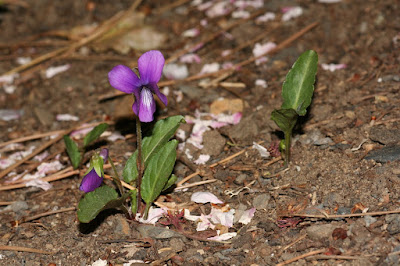
I've only been in Japan for about a month, and in Maebashi, where I will be living for the next year, for under 2 weeks. So far most of the plants that I have found have been introduced, mostly from China, but I wanted to start the blog off with a native plant. To my pleasant surprise, I found a nice native violet while I was on my way to photograph another non-native plant which I'll cover later. I found it in quite an idyllic spot too. Gunma prefecture is quite famous for its ancient burial mounds, and those from the Kofun Period (古墳時代), which ran from 250-538 AD, are shaped like giant keyholes (in fact there is one just 50 meters from my apartment!). I found this plant on a burial mound, but it wasn't a Kofun one as it was just a nondescript mound, and it had modern graves on it, so it was either old and reused or else relatively recent, though it did have trees that were at least 60 years old on it.
 The Manchurian violet (Viola mandschurica W. Becker), or 菫 (read as "sumiré"), is probably the most common violet species in the country, at least from what I can gather. Indeed, the name "sumiré" is a general term for violets, but this species is so common that no further descriptive adjective is added to the name: it is "the violet" in Japan, as it were. The flora that I'm using, The Flora of Japan (in English) by Jisaburō Ohwi, states that it is "very common" and is found on all the major islands of Japan (not including the Ryukyu Islands, as they weren't a part of Japan when the flora was published in 1965). I've seen it growing in the cracks of pavement and in little spaces on walls. The ones I found photographed were practically carpeting the ground under a number of cherry trees, but with good light coming in from the south. In fact, on the north side of the hill I didn't see any, so shade is proabaly a strongly limiting factor in their habitat preference. The flora says they're typical of "grassy places and fields in lowlands and hills".
The Manchurian violet (Viola mandschurica W. Becker), or 菫 (read as "sumiré"), is probably the most common violet species in the country, at least from what I can gather. Indeed, the name "sumiré" is a general term for violets, but this species is so common that no further descriptive adjective is added to the name: it is "the violet" in Japan, as it were. The flora that I'm using, The Flora of Japan (in English) by Jisaburō Ohwi, states that it is "very common" and is found on all the major islands of Japan (not including the Ryukyu Islands, as they weren't a part of Japan when the flora was published in 1965). I've seen it growing in the cracks of pavement and in little spaces on walls. The ones I found photographed were practically carpeting the ground under a number of cherry trees, but with good light coming in from the south. In fact, on the north side of the hill I didn't see any, so shade is proabaly a strongly limiting factor in their habitat preference. The flora says they're typical of "grassy places and fields in lowlands and hills". It's not only in Japan that this plant is common. In fact, it's quite widespread, and is found in the Russian Far East, Korea, Taiwan, and throughout eastern China down to Fujian and all the way up to Inner Mongolia and Manchuria, whence it's English and scientific names.
It's not only in Japan that this plant is common. In fact, it's quite widespread, and is found in the Russian Far East, Korea, Taiwan, and throughout eastern China down to Fujian and all the way up to Inner Mongolia and Manchuria, whence it's English and scientific names.Anyways, it's distinguished by its winged, broad, short leaf stalks ending in a deltoid-lanceolate (i.e. triangular-lance-shaped), somewhat thick leaf, as well as by its dark-purple flowers, though occasionally white ones with purple striations turn up. You can see the winged petioles as well as the leaf shape in the first photo. The lateral petals are usually bearded on the inside, but they are sometimes glabrous (i.e. hairless), such as the ones I photographed. Also notice the 5-8 mm sepals on the unopened flower. The roots are orange brown, which differentiates this species from some others with white roots. For a detailed line drawing, please click on the Flora of China illustration in the links section at the bottom of this posting.
 Apparently the plant is grown in the West by violet enthusiasts, particularly a cultivar called 'Fuji Dawn' that has very beautifully variegated leaves. Here is a link to a photo of the cultivar.
Apparently the plant is grown in the West by violet enthusiasts, particularly a cultivar called 'Fuji Dawn' that has very beautifully variegated leaves. Here is a link to a photo of the cultivar.Here are some links to more information:
Flora of China Treatment
Flora of China Illustration
Japanese Wikipedia Entry
No comments:
Post a Comment